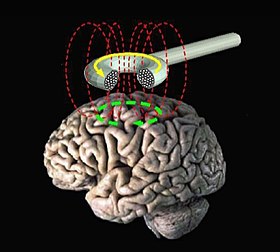경두개자기자극술
경두개자기자극술(經頭蓋磁氣刺激術, transcranial magnetic stimulation (TMS))은 자기장의 변화를 통한 전류를 이용한 비침습적 뇌자극법이다. 코일을 두개에 가까이 위치시켜 자기장을 변화시키면, 변화한 자기장에 의해 뇌 안에서 전자기 유도에 의한 전기장이 형성된다.[1]:3[2]
| 경두개자기자극술 | |
|---|---|
 경두개자기자극술 | |
| 진료과 | 정신의학, 신경학 |
| MeSH | D050781 |
중추신경계와 관련된 질병을 진단하거나 치료하는데 이용된다. 현재에도 연구가 활발히 진행된다.[3][4][5][6][7][8][9][10]
드문 경우이지만 졸도나 경련 등의 부작용이 나타나기도 한다.[11] 이외에는 불편감, 고통, 경조증, 인지 능력의 변화, 귀울림 등의 부작용이 발생하기도 하며, 제세동기 등 금속 보철물을 삽입한 경우에는 의도치 않은 전류가 발생할 수 있다.[11]
같이 보기
편집각주
편집- ↑ NICE. January 2014 Transcranial magnetic stimulation for treating and preventing migraine
- ↑ Michael Craig Miller for Harvard Health Publications. July 26, 2012 Magnetic stimulation: a new approach to treating depression?
- ↑ Groppa S, Oliviero A, Eisen A, Quartarone A, Cohen LG, Mall V, 외. (May 2012). “A practical guide to diagnostic transcranial magnetic stimulation: report of an IFCN committee”. 《Clinical Neurophysiology》 123 (5): 858–82. doi:10.1016/j.clinph.2012.01.010. PMC 4890546. PMID 22349304.
- ↑ Lefaucheur JP, André-Obadia N, Antal A, Ayache SS, Baeken C, Benninger DH, 외. (November 2014). “Evidence-based guidelines on the therapeutic use of repetitive transcranial magnetic stimulation (rTMS)”. 《Clinical Neurophysiology》 125 (11): 2150–2206. doi:10.1016/j.clinph.2014.05.021. PMID 25034472. S2CID 206798663.
- ↑ George, Mark S.; Post, Robert M. (April 2011). “Daily Left Prefrontal Repetitive Transcranial Magnetic Stimulation for Acute Treatment of Medication-Resistant Depression”. 《American Journal of Psychiatry》 168 (4): 356–364. doi:10.1176/appi.ajp.2010.10060864. PMID 21474597.
- ↑ Gaynes, Bradley N.; Lux, Linda J.; Lloyd, Stacey W.; Hansen, Richard A.; Gartlehner, Gerald; Keener, Patricia; Brode, Shannon; Evans, Tammeka Swinson; Jonas, Dan; Crotty, Karen; Viswanathan, Meera; Lohr, Kathleen N. (2011). “Nonpharmacologic Interventions for Treatment-Resistant Depression in Adults”. AHRQ Comparative Effectiveness Reviews. Agency for Healthcare Research and Quality. PMID 22091472.
- ↑ Berlim, Marcelo T; Van den Eynde, Frederique; Jeff Daskalakis, Z (2012년 11월 19일). “Clinically Meaningful Efficacy and Acceptability of Low-Frequency Repetitive Transcranial Magnetic Stimulation (rTMS) for Treating Primary Major Depression: A Meta-Analysis of Randomized, Double-Blind and Sham-Controlled Trials”. 《Neuropsychopharmacology》 38 (4): 543–551. doi:10.1038/npp.2012.237. PMC 3572468. PMID 23249815.
- ↑ Perera, Tarique; George, Mark; Grammer, Geoffrey; Janicak, Philip; Pascual-Leone, Alvaro; Wirecki, Theodore (2015년 4월 27일). TMS Therapy For Major Depressive Disorder: Evidence Review and Treatment Recommendations for Clinical Practice (PDF) (보고서).
- ↑ Bersani, F.S.; Minichino, A.; Enticott, P.G.; Mazzarini, L.; Khan, N.; Antonacci, G.; Raccah, R.N.; Salviati, M.; Delle Chiaie, R.; Bersani, G.; Fitzgerald, P.B.; Biondi, M. (January 2013). “Deep transcranial magnetic stimulation as a treatment for psychiatric disorders: A comprehensive review”. 《European Psychiatry》 28 (1): 30–39. doi:10.1016/j.eurpsy.2012.02.006. PMID 22559998. S2CID 29053871.
- ↑ Dougall N, Maayan N, Soares-Weiser K, McDermott LM, McIntosh A (August 2015). “Transcranial magnetic stimulation (TMS) for schizophrenia” (PDF). 《The Cochrane Database of Systematic Reviews》 8 (8): CD006081. doi:10.1002/14651858.CD006081.pub2. hdl:1893/22520. PMID 26289586.
- ↑ 가 나 Rossi; 외. (January 2021). “Safety and recommendations for TMS use in healthy subjects and patient populations, with updates on training, ethical and regulatory issues: Expert Guidelines.”. 《Clinical Neurophysiology》 132 (1): 269–306. doi:10.1016/j.clinph.2020.10.003. PMID 33243615. S2CID 225049093.